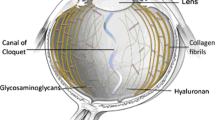Abstract
The object of this study was to improve the isolation procedure of hyaluronan and to compare characteristics of hyaluronan from the eyeball of bigeye tuna Thunnus obesus with other sources. General sources of hyaluronan are from Streptococcus zooepidemicus and rooster comb. Hyaluronan can be also obtained from the vitreous of fish eyes. Pure hyaluronan of higher molecular weight was obtained by the following improved extraction procedure: the frozen vitreous of a tuna eyeball was used to avoid contamination with blood, muscle tissue, and other factors; extracting was carried out over a long time period under cold conditions; cetylpyridinium chloride was used in order to separate mucopolysaccharides containing hyaluronan in the initial procedure without the process of removing fat and protein by reagents. The hyaluronan obtained was characterized by gel permeation chromatography, dynamic light scattering measurements, and viscometry. The characteristics of hyaluronan from tuna eyeballs were similar to those from other sources. However, the viscosity was lower. The possible reason could be ascribed to the wide distribution of molecular size in the vitreous humor of fish eye.







Similar content being viewed by others
References
Boas NF (1949) Isolation of hyaluronic acid from the cock’s comb. J Biol Chem 181:573
Lago G, Oruna L, Cremata JA, Perez C, Coto G, Lauzan E, Kennedy JF (2005) Isolation, purification and characterization of hyaluronan from human umbilical cord residues. Carbohydr Polym 62:321–326
Sunwoo HH, Nakano T, Sim JS (1998) Isolation and characterization of proteoglycans from growing antlers of wapiti. Comp Biochem Physiol B Biochem Mol Biol 124:437–442
Devaraj N, Bhavanandan VP (1992) Purification of mucin glycoprotein by density gradient centrifugation in cesium trifluroacetate. Analy Biochem 206:142–146
Meyer K, Palmer JW (1934) The polysaccharide of the vitreous humor. J Biol Chem 107:629–634
Laurent TC (1970) Structure of hyaluronic acid. In: Balazs EA (ed) Chemistry and molecular biology of the intercellar matrix. Academic Press, New York
Meyer K (1958) Chemical structure of hyaluronic acid. Fed Proc 17:1075–1077
Soltes L, Mendichi R, Kogan G, Schiller J, Stankovska M, Arnhold J (2006) Degradative action of reactive oxygen species on hyaluronan. Biomacromolecules 7:659–668
Scott JE (1992) The chemical morphology of vitreous. EYE 6:553–555
Dittmar H (1998) Der aktuelle Stand der BSE-Verordmumgen: Verwendungsverbote fuer Risikomaterial in kosmetischen Mitteln. (The present state of BSE regulations: prohibition of use of hazardous material in cosmetics). Parfuem Kosmet 79:14–16 (in German)
Rimpler M (1996) BSE-Rinderwahnsinn und seine Bedeutung fuer die Kosmetik. (BSE-bovine madness and its impact on cosmetics). Parfuem Kosmet 77:404–408 (in German)
Shiedrin A, Bigelow R, Christopher W, Yang L, Miller RJ, Arbabi S, Maier RV (2004) Evaluation of hyaluronan from different sources: Streptococcus zooepidemicus, rooster comb, bovine vitreous, and human umbilical cord. Biomacromolecules 5:2122–2127
Mizuno H, Iso N, Saito T, Ogawa H, Sawairi H, Saito M (1991) Characterization of hyaluronic acid of yellowfin tuna eyeball. Nippon Suisan Gakkaishi 57:517–519
Matsumura G, Salegui MD, Herp A, Pigman W (1963) The preparation of hyaluronic acid from bovine synovial fluid. Biochimi Biophys Act 69:574–576
Bettelheim FA, Paunovic M (1979) Light scattering of normal human lens. I. Application of random density and orientation fluctuation theory. Biophys J 26:85–99
Kohn J (1957) A cellulose acetate supporting medium for zone electrophoresis. Clin Chem Acta 2:297
Swann DA (1968) Studies on hyaluronic acid: I. The preparation and properties of rooster comb hyaluronic acid. Biochim Biophys Acta 156:17–30
Matsumura G (1971) Hyaluronic acid. Tanpakushitsu Kakusan Koso (Protein Nucleic Acid and Enzyme) 16:233–238 (in Japanese)
Ansari RR, Suh KI, Dunker S, kitaya N, Sebag J (2001) Quatitative molecular characterization of bovine vitreous and lens with non-invasive dynamic light scattering. Eye Res 73:859–866
Balazs EA (1960) Physiology of the vitreous body. In: Schepens (ed) Importance of the vitreous body in retina surgery with special emphasis on reoperations. St Louis, Mosby
Balazs EA, Denlinger JL (1984) The vitreous. In: Davson J (ed) The eye. Academic Press, New York, pp 535–589
Author information
Authors and Affiliations
Corresponding author
Rights and permissions
About this article
Cite this article
Amagai, I., Tashiro, Y. & Ogawa, H. Improvement of the extraction procedure for hyaluronan from fish eyeball and the molecular characterization. Fish Sci 75, 805–810 (2009). https://doi.org/10.1007/s12562-009-0092-2
Received:
Accepted:
Published:
Issue Date:
DOI: https://doi.org/10.1007/s12562-009-0092-2




